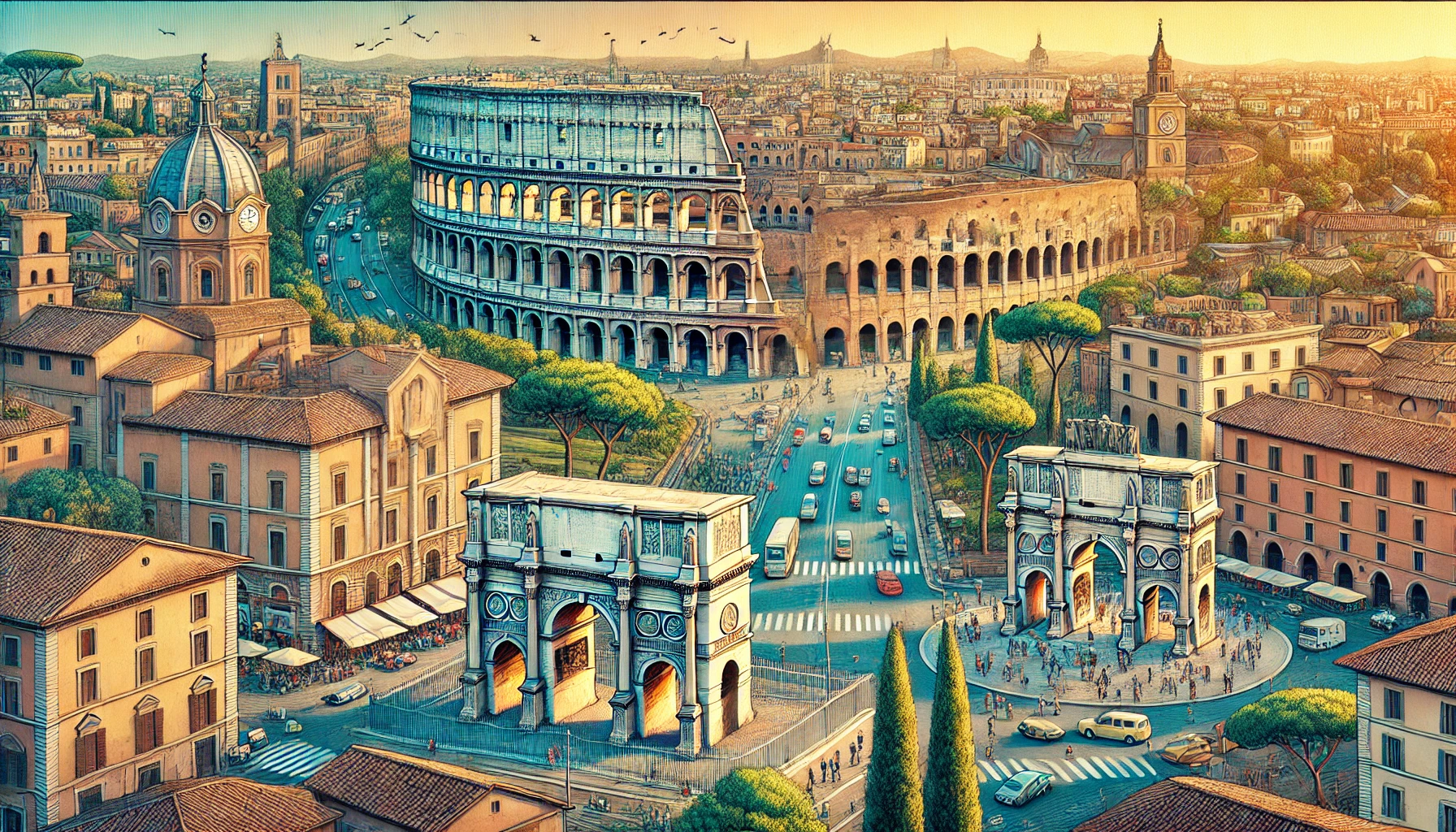A must-see on the itinerary of nearly every visitor to Rome, the Colosseum is the largest amphitheater of the ancient world, showcasing a perfect blend of history, art, and architecture. Also known as the “Flavian Amphitheater,” this awe-inspiring structure continues to exude the grandeur of ancient Rome even today. If you’re spending a few days in Rome, placing the Colosseum at the top of your list is one of the most captivating ways to connect with the city’s rich history. Let’s dive into the details of this iconic marvel of Ancient Rome!
Where is the Colosseum?
It’s located in the heart of Rome, Italy’s capital, within the ancient city area. As one of Rome’s most famous landmarks, it attracts millions of tourists every year. Situated in the Monti district, the Colosseum is surrounded by other historic sites, including the Roman Forum and Palatine Hill, making it a central hub for a comprehensive exploration of Roman history.
Positioned east of the Tiber River, the Colosseum stands in the core of Rome’s ancient city center. It is within walking distance of many of the city’s key attractions and is easily accessible via public transportation.
A Marvel of Ancient Engineering

Construction of the Colosseum began under Emperor Vespasian in AD 70-80 and was completed during the reign of his son Titus. The elliptical structure measures approximately 188 meters in length, 156 meters in width, and 48 meters in height. Capable of accommodating between 50,000 and 80,000 spectators, this colossal amphitheater is one of the most remarkable engineering feats of the Roman era.
One of the Colosseum’s most striking features is its layered architecture. Each level showcases a different order of columns: Doric, Ionic, and Corinthian. The arched structures surrounding the exterior, along with the niches designed for massive statues, give the Colosseum its monumental and timeless grandeur.
Visitor Tip
To enjoy there without the crowds, plan your visit early in the morning or late in the afternoon. This will not only provide a more tranquil experience but also allow for uninterrupted photography. Booking tickets online in advance is highly recommended to avoid long queues.
The Center of Gladiatorial Combat and Entertainment

The Colosseum was built to provide free entertainment for the people of Rome. It hosted gladiatorial combats, wild animal hunts, and even elaborate naval battle simulations. The arena floor was made of a wooden platform, beneath which lay the complex underground system known as the “Hypogeum.” This network of tunnels and chambers was used to house animals and prepare gladiators before they emerged onto the stage for their dramatic entrances.
Visitor Tip:
Colosseum tickets often include entry to the Roman Forum and Palatine Hill. Combine your visit to the Colosseum with a broader historical tour for a richer experience.
The Symbolism of the Colosseum

The Colosseum was not just a center of entertainment but also a significant symbol for understanding the social and political structure of Rome.
- Social Hierarchy: The seating arrangement vividly reflected the class distinctions in Roman society. The emperor and senators sat closest to the arena, occupying the most prestigious seats, while the lower classes and women were relegated to the uppermost levels, furthest from the action.
- Cultural Convergence: Exotic animals and gladiators brought from various parts of the Roman Empire came together in the Colosseum, symbolizing the cultural diversity and reach of the empire.
Where Does the Name “Colosseum” Come From?
The name “Colosseum” derives from the “Colossus of Nero,” a massive statue that once stood near the amphitheater. During its early years, the structure was officially known as the Flavian Amphitheater (Amphitheatrum Flavium). Over time, people began referring to it as the Colosseum, a nod to Nero’s colossal statue, which was an iconic landmark of the area. The name gained widespread use during the Middle Ages and remains the common term for the structure today.
The Colossus of Nero

- The History of the Statue: Built during Nero’s reign, this colossal bronze statue stood approximately 30 meters tall and was designed as part of the Domus Aurea (Golden House) palace complex. It depicted Emperor Nero as a solar deity, symbolizing his divine authority and grandeur.
- Location Near the Colosseum: Positioned right next to where the Colosseum now stands, the statue rested on an enormous pedestal. After Nero’s death, the statue became a symbol for the Roman people and was altered by subsequent emperors. For example, Nero’s head was replaced with the likeness of the sun god Sol Invictus, reflecting a shift in its symbolic meaning.
Evolution and Popularization of the Name “Colosseum”
- The Term “Colosseum”: Derived from the Latin word colossus, meaning “gigantic” or “massive,” the name was inspired by Nero’s statue, which was one of the most prominent landmarks in the area.
- Medieval Usage: Although it was officially called the Flavian Amphitheater in antiquity, during the Middle Ages, the structure began to be referred to as the “Colosseum” due to its proximity to the colossal statue.
- Modern-Day Name: While the statue no longer exists, the name “Colosseum” has endured and is now universally recognized as the title of this iconic structure.
The Current State of the Colosseum

Though parts of the Colosseum have succumbed to the effects of time, the remaining sections stand as a treasure trove for history enthusiasts. Listed as a UNESCO World Heritage Site, it is one of the most visited attractions in Rome. In 2007, the Colosseum was also named one of the New Seven Wonders of the World, further solidifying its status as a global icon.
At night, the illuminated Colosseum offers a magical sight, creating an unforgettable atmosphere for visitors. During summer, guided nighttime tours provide a unique perspective on its rich history, allowing you to explore the monument under a different light.
How to Prepare for a Colosseum Visit
As one of Rome’s most popular landmarks, visiting the Colosseum requires a bit of planning:
- Wear Comfortable Clothing and Shoes: Navigating the site involves a lot of walking, so comfort is key.
- Prepare for the Heat: Summers in Rome can be quite hot, so bring a hat and water to stay hydrated.
- Opt for Guided Tours: To gain deeper insights into the Colosseum’s history and hidden details, consider joining a guided tour.
Visitor Tip:
Use tourist cards like the Roma Pass or OMNIA Card to enjoy discounts or skip-the-line privileges when visiting the Colosseum. These cards can also cover entry to other major attractions, making them a convenient option for exploring the city.
How to Get to the Colosseum

By Metro
The fastest way to reach the Colosseum is via the metro. Take Rome’s Line B (Blue Line) and get off at the “Colosseo” station, which is conveniently located right in front of the Colosseum.
By Bus
Several bus routes provide access to the Colosseum. Notable routes include 75, 81, 175, and 204, all of which stop near the site.
By Tram
The Tram 3 line passes close to the Colosseum, offering another convenient option for visitors.
On Foot
The Colosseum is within walking distance of many central locations in Rome. From Piazza Venezia, it’s roughly a 15-minute walk to the Colosseum, making it a pleasant stroll through the historic streets of Rome.
Places to See Around the Colosseum

When visiting there, don’t miss the chance to explore the historic landmarks nearby. Here are some must-see spots in the vicinity:
- Roman Forum: Once the political, commercial, and religious hub of Ancient Rome, the Forum’s ruins offer a fascinating glimpse into history and a chance to walk where Roman senators and citizens once gathered.
- Palatine Hill: One of Rome’s seven hills, Palatine offers not only incredible historical significance as the birthplace of Rome but also stunning views of the city.
- Arch of Constantine: Located right next to the Colosseum, this triumphal arch commemorates Emperor Constantine’s victory at the Battle of the Milvian Bridge and symbolizes the power of the Roman Empire.
Cities with Colosseum-Inspired Structures
The Colosseum, as an icon of Roman architecture, has inspired similar structures around the world. Here are some notable examples:
1. El Djem Amphitheater – El Djem, Tunisia
- Details: Built in the 3rd century AD, this amphitheater is one of the most famous Colosseum-like structures in Africa. With a seating capacity of around 35,000, it is a remarkable reminder of Roman influence in the region and a major Tunisian tourist attraction.
2. Amphitheatre in Pula – Pula, Croatia
- Details: Located in Pula, Croatia, this 1st-century AD amphitheater is another prominent example. With a capacity of 20,000 spectators, it hosted gladiatorial games during the Roman Empire.
3. Arena di Verona – Verona, Italy
- Details: This smaller version of the Colosseum, built in the 1st century AD, is in Verona, Italy. Today, it is a famous venue for open-air concerts and opera performances, blending ancient history with modern art.
4. Arles Amphitheatre – Arles, France
- Details: Built as a replica of the Colosseum in Southern France, this 20,000-seat structure dates back to the Roman Empire. It now serves as a venue for cultural events and performances.
5. Nîmes Amphitheatre – Nîmes, France
- Details: Constructed in the 1st century AD, this amphitheater in Nîmes was inspired by the Colosseum. With a capacity of 24,000, it is one of the largest Roman amphitheaters in France and remains a venue for public events.
6. Capua Amphitheatre – Santa Maria Capua Vetere, Italy
- Details: Located near Naples, this amphitheater is the second-largest in Italy after the Colosseum. Built in the 1st century AD, it became famous for its gladiatorial games.

7. London Coliseum – London, United Kingdom
- Details: While not a direct replica of the ancient Colosseum, the London Coliseum pays homage to its namesake in its architectural design and name. Built in 1904, it now serves as a renowned theater and opera house.
8. Macellum of Pozzuoli – Pozzuoli, Italy
- Details: Though smaller than the Colosseum, this ancient structure in Pozzuoli reflects the design of Roman-era entertainment venues, offering a glimpse into the local adaptations of amphitheaters.
9. Gavle Coliseum – Gavle, Sweden
- Details: This modern sports arena draws inspiration from the Colosseum in its design, blending Roman influence with contemporary functionality.
10. Los Angeles Memorial Coliseum – Los Angeles, USA
- Details: A modern interpretation, this 1923-built stadium takes its name from the ancient Colosseum. It serves as a major sports and events venue, nodding to the grandeur and versatility of its Roman predecessor.
11. Replica Colosseum – Macau, China
- Details: This modern replica in Macau recreates the atmosphere of ancient Rome, designed for performances and events. It offers visitors a chance to experience the aura of the Colosseum in a new setting.
12. The O2 Arena – London, United Kingdom
- Details: A state-of-the-art event space, the O2 Arena incorporates elements inspired by the Colosseum in its architectural design, showcasing its enduring influence on modern structures.
The Timeless Legacy of the Colosseum
The Colosseum remains not only an engineering marvel of Ancient Rome but also a profound symbol of its culture, power, and the lives of its people. Structures inspired by the Colosseum, both ancient and modern, highlight its role as a cultural beacon across centuries.
Walking through the Colosseum’s weathered stones, you can almost hear the clash of gladiators, the roar of the crowd, and the presence of emperors asserting their dominance. This extraordinary amphitheater offers a journey through time, preserving the essence of Ancient Rome while continuing to captivate history enthusiasts and travelers alike.
Visiting the Colosseum is not just a trip to a historic site; it’s an immersion into the cultural heritage of humanity. Don’t miss the chance to experience its grandeur!
